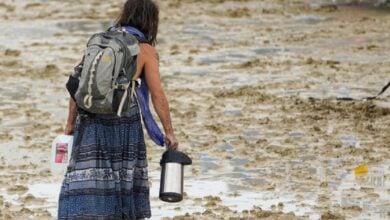Endangered Formosan black bear released into Taiwanese wild
Ziman the Formosan black bear returns to wild after paw amputation

Conservationists in Taichung, Taiwan, released an endangered Formosan black bear back into the wild, accompanied by gunshots and air horns to encourage the bear to quickly retreat into the central Taiwanese mountains. The young bear, Ziman, had recovered from a paw amputation caused by a hunter’s steel trap and was given another chance at life.
Pihao Payen, the leader of a local Atayal community, prayed for Ziman’s safe journey and protection from traps as the bear vanished into the wilderness. Dressed in traditional attire, the 74-year-old chief also called upon his ancestors for assistance in keeping Ziman safe.
Taiwanese hunters and conservationists are collaborating to protect the Formosan black bear, with only a few hundred believed to remain in the wild. They are developing new traps that do not cause severe injuries if bears are accidentally caught.
While these bears are not the intended targets for indigenous hunters, accidental captures have occurred, including two recent incidents in Pihao Payen’s village. Since 2014, 18 bears have been caught in traps, with six fatalities, according to the Taiwan Black Bear Conservation Association. Some bears suffered severe injuries from old-fashioned metal snares.
Liu Li-wen, an animal caretaker at a government-run bear shelter in Taichung, detailed Ziman’s injury and recovery. She explained how steel snares tighten around the animals, leading to severe injuries or necrosis. Vets amputated most of Ziman’s paw after two months of treatment to save his life.
The Formosan black bear, native to sub-tropical Taiwan and distinguished by a V-shaped white mark on its chest, symbolizes Taiwanese identity. The Forestry and Nature Conservation Agency is promoting new traps that only capture smaller prey and do not cause severe injury. Over 5,600 of these traps have been distributed to hunters and farmers across Taiwan, with monetary rewards for reporting bear captures.
Pan Wen-ming, an Amis hunter and guava farmer, demonstrated the new traps’ functionality, explaining that their design prevents bears from being fully ensnared. Chen Yen-long, head of the Wushikeng Research Centre bear shelter, noted that some hunters kill snared bears to avoid prosecution.
Tragically, Ziman was found dead in the central mountains weeks after his release, with the cause of death undetermined. Lai Chiao Ling, one of Ziman’s caretakers, expressed determination to continue their efforts, emphasizing the importance of preserving the remaining wild bears.
What Other Media Are Saying
- Reuters investigates the snaring crisis in Taiwan, highlighting the plight of endangered Formosan black bears and the challenges in combatting wildlife poaching. (read more)
- Hindustan Times reports on the collaboration between hunters and conservationists to protect the Formosan black bear, highlighting the joint efforts to manage and maintain the species’ population. (read more)
Frequently Asked Questions
Here are some common questions asked about this news
What happened to the Formosan black bear named Ziman?
Ziman, a young bear with an amputated paw, was released back into the wild but was found dead weeks later.
Why are conservationists and hunters in Taiwan working together?
They are collaborating to protect the endangered Formosan black bear by designing traps that don’t cause severe injuries.
What is special about the new traps being used in Taiwan?
The new traps are designed to capture smaller prey without tightening to the point of causing limb amputation.
How many Formosan black bears are estimated to still be in the wild?
Only a few hundred Formosan black bears are estimated to still be in the wild.
What measures are being taken to encourage the use of new traps?
Over 5,600 new traps have been distributed for free, and monetary rewards are given for reporting bears caught in traps.







